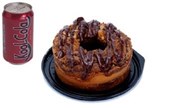The 2010 Dietary Guidelines provide key points to follow for an ideal eating plan. The guidelines reveal ways your daily diet could be contributing to excess weight gain and chronic diseases, or it can lead you to better health and vitality. It only takes a small change from what you are currently eating to put the right foods on your plate and in your mouth.
The 2010 Dietary Guidelines provide recommendations for foods we should be eating more often or less often. The bottom line is to keep calories in balance to maintain a healthy weight. This means you have to find foods to swap; replace the less healthful food options with better ones. You can still enjoy what you are eating while reducing or maintaining your weight and getting all of the nutrients your body needs to feel great.
Chances are, nearly a third of your diet consists of added sugar and solid fat. This means you are consuming far too much of the foods and drinks that are not good for your health or your waistline. The 2010 Dietary Guidelines strongly recommend a reduction in foods high in added sugar and solid fat.
Added sugars are sweeteners that do not occur naturally in the food you eat. For example, an orange is sweetened naturally. However, orange flavored sports drinks include added sugars (such as corn syrup), and this sweetener would have been put in during processing. These are the added sugars that should be reduced.
Top Contributors of Sugar to the American Diet
- Sugar-sweetened beverages (49.7%)
- Desserts (25.5%)
- Ready-to-eat cereals (3.8%)
Solid fat is another name for saturated fat and trans-fat. Reducing the amount of saturated and trans-fat in your diet is recommended for better health. Fat that is solid at room temperature, such as shortening, margarine, lard, animal fat and skin, butter, and cheese, are all linked to an increased risk of cardiovascular disease. Fat that is liquid, such as oil, is healthier for you, and may reduce your risk of many chronic diseases. Liquid fat contains higher amounts of mono and poly unsaturated fat.
Top Contributors of Solid Fats to the American Diet
- Desserts (15.5%)
- Eggs, bacon & sausage (10.8%)
- Pizza (9.1%)
- Hamburgers & fried potatoes (8.6%)
- Butter, margarine, lard and shortening in pasta and Mexican food dishes (8.5%)
- Whole and low-fat milk (7.3%)
- Chicken & beef (7%)







